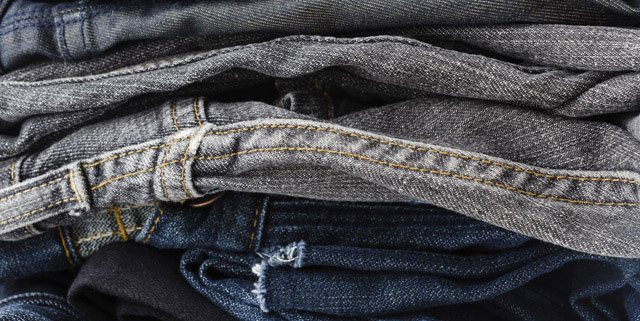Everyone has a favorite pair of denim jeans — until they start fraying or ripping. At one time, some funky patches might have helped to cover the holes and prolong the life of the jean. But these days, recycling is giving denim an extended run.
[quote]Some store chains are collecting denim to have it reprocessed for alternative uses, while other retailers and brands are selling garments made from recycled denim.
H&M, long known for its fast fashion, started collecting used apparel last year to reduce the amount that ends up in landfills. The fibers from those collected garments have been turned into five men’s and women’s denim styles, including jackets and jeans, to be sold in select stores starting this month.
“Recycling these materials into new garments allows us to close the loop on the lifecycle of a garment – hence the name Close The Loop collection,” says H&M’s Nicole Christie, spokesperson. “Both our Conscious (made from sustainable materials) and Close the Loop collections are at the forefront of fashion and sustainability. They show very clearly that choosing greener fashion does not mean compromising on design or price. We hope by consistently providing these Conscious products to our customers, we can help make a better choice easier for our shoppers, while applying these innovations on a bigger scale.”
Such a program also supports a growing consumer wish to do the right thing environmentally — even when it comes to their jeans. As it happens, most (74%) of consumers “like or love” their denim jeans, according to the Cotton Incorporated Lifestyle Monitor™ Survey. In fact, the average U.S shopper owns seven pairs. While this could lead to a lot of denim getting tossed when it no longer fits or a hole is blown in the knee, most consumers attempt to repurpose their jeans by donating them to charity (51%), giving them away (14%), re-using them in a different way (6%), or selling them (5%). Just 10% of consumers throw away jeans they no longer plan to wear, according to Monitor data.
J. Crew became one of the latest players in the denim recycling movement when it joined Cotton Incorporated’s Blue Jeans Go Green™ program. From Feb. 17 to March 3, participating stores have collected pre-worn denim from customers. Those who dropped off a used pair of jeans and purchased a new pair received 15% off their entire order.
Over the past eight years, the Blue Jeans Go Green™ denim recycling program has collected more than 1 million pieces of denim. These efforts have diverted more than 600 tons of waste from landfills and equal approximately 2 million square feet of UltraTouch™ Denim Insulation to assist with building efforts in communities in need.
Since the start of the program in 2006, the insulation has been distributed to Habitat for Humanity affiliates around the country. As another avenue for distribution, Cotton launched a Grant Program in 2010 for architects, contractors, builders and project developers to apply for grants of UltraTouch™ Denim Insulation for community-based buildings.
Technology has played a significant role in turning denim into an innovative product, while still maintaining its image as a strong and durable heritage fabric. At the recently held Première Vision show, Jeanologia won the WGSN Global Fashion Award in the Best Sustainable Design Team category. One of its innovations is using laser and ozone technology on recycled denim, “and getting amazing results,” says Carmen Silla, who leads digital marketing strategies, adding, “We are collaborating with Cotton Incorporated on developing its new FABRICAST™ collection, working in different fabrics.”
Jeanologia’s textile laser reproduces vintage and worn effects on garments without the use of harsh chemicals, as well as saving on water and energy usage. The ozone-based techniques include the eco-washer G2. It washes jeans and T-shirts with ozone and oxygen, using no water or chemicals, to give the garments a vintage finish.
“This technology translates into a 67% water savings per garment, 85% savings in chemicals and 62% savings in energy,” Silla says.
Ultimately, these technologies benefit both planet and industry. While just a third of consumers are likely to seek out eco-conscious clothes for themselves, 69% would be bothered if they discovered a purchase was not environmentally friendly, according to the Cotton Incorporated 2013 Environment Survey. Further, 40% would blame the manufacturer, followed by the brand (14%), and themselves (12%).
Because H&M was known for its low-priced trendy apparel, it gained a reputation for carrying “disposable” clothes — garments that could be worn just a few times and then thrown out. Its newest collection and recycling program go a long way toward overcoming that perception.
Christie says the Close the Loop line, which will be carried in 2,000 stores for men and 800 for women, contains 20% recycled cotton, which is the maximum amount that can be used today when making new fabric.
“The aim is to use more material from recycled post-consumer garments in the future,” she says. “Making greener product choices available to all our customers around the world allows us to work together to contribute to a more sustainable fashion future.”
